#native Canadian plants
Explore tagged Tumblr posts
Photo

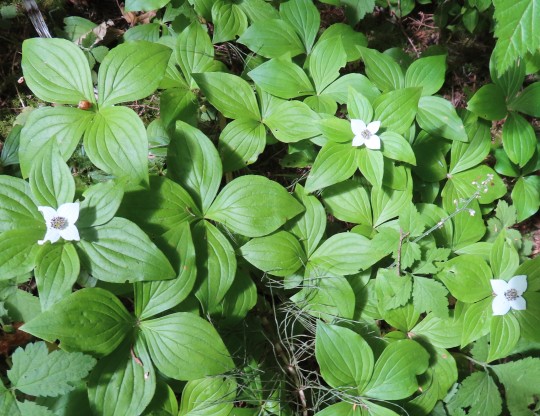

Cornus canadensis (Canadian bunchberry)
About a month ago I was talking to a neighbor about her pink dogwood tree and she showed me a four petaled, white flower in her garden. She said it had just “shown up” last year and wondered if this was a dogwood too. “Oh no,” I said, “dogwoods are either shrubs or small trees. I’ve never seen a dogwood growing as a groundcover before.”
Of course this conversation raised an element of doubt and as soon as I got home I opened my copy of Plants of Coastal British Columbia (revised edition) and there it was on page 320, Cornus canadensis. A week later I was walking the forest trails in Stanley Park and I found it all over the place.
This wildflower is native to Canada, Greenland, Northern China, North Korea, Japan, parts of Siberia and a number of US states. Although most dogwoods are shrubs and small trees, two species, Canadian bunchberry and Alaskan bunchberry (Cornus × unalaschkensis) grow between four and eight inches tall.
#flowers#photographers on tumblr#Canadian bunchberry#dogwood#native plant#fleurs#flores#fiori#blumen#bloemen#Stanley Park#Vancouver
88 notes
·
View notes
Text
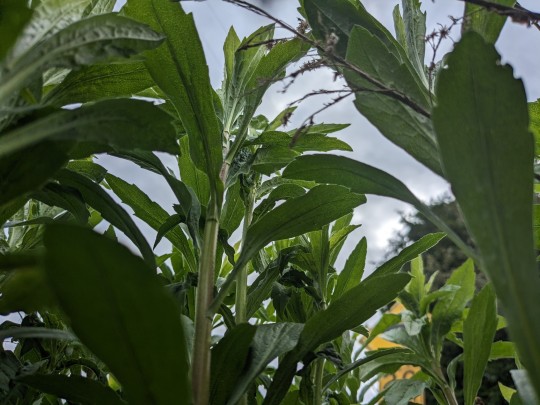
pov youre a bug under the salidago canadensis
130 notes
·
View notes
Text

Viola canadensis / Tall White Violet at the Sarah P. Duke Gardens at Duke University in Durham, NC
#Viola canadensis#Viola#violaceae#Tall white violet#White violet#Canadian white violet#Canada violet#Edible plants#Edible flowers#Native plants#Native flowers#Plants#Flowers#Nature photography#photographers on tumblr#photography#Sarah P. Duke Gardens#Duke Gardens#Duke University#Durham#Durham NC#North Carolina#🌺🌻
12 notes
·
View notes
Text
Everything I see that happens to Palestinians literally happened & is happening to Native Americans like its insane
#our oppression mirrors each other#theres differences of course bc our histories of colonization & race & religion are different#but thats what makes the similarities so chilling#Israel controlling Palestine's water supply & making escape or defending yourself nigh impossible#& removing all the Native plants like the Olive trees & replacing them with invasive plants#or the extinction of the Palestinian crocodile vs the Plains Bison#how settlers will defend their colonization & how ive seen a settler say that Israel 'uses the land properly'#everything I've seen settlers say defending Israel is the exact same thing I've seen settler Canadians & Americans say
47 notes
·
View notes
Text

Vegan Bannock (Fry Bread)
#vegan#breakfast#snacks#appetizer#canadian cuisine#native american cuisine#flatbread#bannock#fry bread#cake flour#plant milk#vegan butter#coconut sugar#sea salt#jam#maple syrup
7 notes
·
View notes
Text
"The world’s largest hornet, an invasive breed dubbed the “murder hornet” for its dangerous sting and ability to slaughter a honey bee hive in a matter of hours, has been declared eradicated in the U.S., five years after being spotted for the first time in Washington state near the Canadian border.
The Washington and U.S. Departments of Agriculture announced the eradication Wednesday [December 18, 2024], saying there had been no detections of the northern giant hornet in Washington since 2021...
“I’ve gotta tell you, as an entomologist — I’ve been doing this for over 25 years now, and it is a rare day when the humans actually get to win one against the insects,” Sven Spichiger, pest program manager of the Washington State Department of Agriculture, told a virtual news conference.
The hornets, which can be 2 inches (5 cm) long and were formerly called Asian giant hornets, gained attention in 2013, when they killed 42 people in China and seriously injured 1,675. In the U.S., around 72 people a year die from bee and hornet stings each year, according to data from the National Institutes of Health.
The hornets were first detected in North America in British Columbia, Canada, in August 2019 and confirmed in Washington state in December 2019, when a Whatcom County resident reported a specimen. A beekeeper also reported hives being attacked and turned over specimens in the summer of 2020. The hornets could have traveled to North America in plant pots or shipping containers, experts said.
DNA evidence suggested the populations found in British Columbia and Washington were not related and appeared to originate from different countries. There also have been no confirmed reports in British Columbia since 2021, and the nonprofit Invasive Species Centre in Canada has said the hornet is also considered eradicated there.
Northern giant hornets pose significant threats to pollinators and native insects. They can wipe out a honey bee hive in as little as 90 minutes, decapitating the bees and then defending the hive as their own, taking the brood to feed their own young.
The hornet can sting through most beekeeper suits, deliver nearly seven times the amount of venom as a honey bee, and sting multiple times. At one point the Washington agriculture department ordered special reinforced suits from China.
Washington is the only state that has had confirmed reports of northern giant hornets. Trappers found four nests in 2020 and 2021.
Spichiger said Washington will remain on the lookout, despite reporting the eradication. He noted that entomologists will continue to monitor traps in Kitsap County, where a resident reported an unconfirmed sighting in October but where trapping efforts and public outreach have come up empty...
“We will continue to be vigilant,” Spichiger said."
-via AP News, December 18, 2024
#murder hornets#insects#entomology#invasive species#endangered species#bees#save the bees#hornets#united states#north america#washington state#british columbia#canada#good news#hope
735 notes
·
View notes
Text
Although in Wood’s 1991 feature for the CBC, former JNF Director of Information Benny Mushkin said that the village of Yalu wasn’t situated within the park’s boundaries and that Canadian taxpayers’ money wasn’t spent on occupied Palestinian territory. “All we did was take the area that was here, reconstructed it, enhanced it and improved it… The area is much, much nicer now than it was before,” Mushkin said.
#i just found this to be so exemplative of the canadian. idk. emotional political mode?#canadian money. 'charity' money goes to putting pine trees up over the unsightly signs of war crimes.#smth smth green colonialism i guess.#making some connections about the view point that a desert is 'barren' that the americas were 'naturally' fertile you know?#that indigenous ppls arent cultivating using native plants and what not. its convient
228 notes
·
View notes
Text

In 1946, Argentina introduced twenty beavers (Castor canadensis) to Tierra del Fuego (TdF) to promote the fur industry in a land deemed empty and sterile.
Beavers were brought from Canada by Tom Lamb, [...] known as Mr. North for having expanded the national frontier [...]. In the 1980s, local scientists [...] found that beavers were the main disturbers of sub-Antarctic forests. The fur industry had never been implemented in TdF and [...] beavers had expanded, crossed to Chile, and occupied most of the river streams. The Beavercene resulted in apocalyptic landscapes [...]: modified rivers, flooded lands, and dead native trees that, unlike the Canadian ones, are not resilient to flooding. [...]
At the end of the nineteenth century the state donated lands to Europeans who, in building their farms, also displaced and assassinated the indigenous inhabitants of TdF. With the settlers, livestock and plants also invaded the region, an “ecological imperialism” that displaced native populations. In doing this, eugenic and racializing knowledges mediated the human and nonhuman population politics of TdF.
---
In the 1940s, the Argentinian State nationalized these settlers’ capitals by redistributing their lands. [...] In 1946, the president of the rural association in TdF opened the yearly livestock [conference]: We, settlers and farmers of TdF have lived the evolution of this territory from the times of an absent State. [...] [T]hey allied with their introduced animals, like the Patagonian sheep or the Fuegian beaver. At a time when, after the two world wars, the category of race had become [somewhat] scientifically delegitimized, the enhancement and industrialization of animals enabled the continuation of racializing politics.
In 1946, during the same livestock ceremony in TdF, the military government claimed:
This ceremony represents the patria; it spreads the purification of our races … It is our desire to produce an even more purified and refined race to, directly, achieve the aggrandizement of Argentina.
---
The increasing entanglement between animal breeding and the nation helped to continue the underlying Darwinist logic embedded in population politics. Previous explicit desires to whiten the Argentinian race started to be actualized in other terms. [...]
Settlers had not only legitimated their belonging to TdF by othering the indigenous [people], [...] but also through the idea that indigenous communities had gone extinct after genocide and disease. At that time, the “myth of extinction” helped in the construction of a uniform nation based on erasing difference, as a geography textbook for school students, Historia y Geografía Argentinas, explained in 1952: If in 1852 there were 900,000 inhabitants divided in 90,000 whites, 585,000 mestizos, 90,000 [Indigenous people] and 135,000 [...] Black, a century later there was a 90% of white population out of 18,000,000 inhabitants. (357) [...] [S]tate statistics contributed to the erasure of non-white peoples through the magic of numbers: it is not that they had disappeared, but that they had been statistically exceeded [...]. However, repressed communities never fully disappear.
---
Text by: Mara Dicenta. "The Beavercene: Eradication and Settler-Colonialism in Tierra del Fuego". Environment & Society Portal, Arcadia (Spring 2020), no. 1. Rachel Carson Center for Environment and Society. [Image by Mara Dicenta, included in original article. Bold emphasis and some paragraph breaks/contractions added by me.]
#ecology#imperial#colonial#abolition#landscape#caribbean#indigenous#multispecies#temporality#haunted#tidalectics
466 notes
·
View notes
Text
Endangered Fireflies & Conservation
Fireflies are at risk of extinction due to habitat destruction, light pollution, and pesticide use. Recovery efforts started in 2023 for the 18 endangered species in North America. Almost 1 in 3 firefly species in the US and Canada are threatened with extinction.
Scientists have yet to prove the effectiveness of these steps due to limited research on firefly populations. However, there is evidence suggesting that human activities may contribute to the decline of fireflies. So, here's what you can do:
Turn off outside lights during nighttime hours
Allow logs and leaves to naturally decompose in your yard
Incorporate areas of water into your landscaping
Refrain from using pesticides in your yard
Avoid excessive mowing of your lawn
Plant native tree species in your yard.
Please take a moment to explore resources related to firefly conservation:
Discover articles from the Xerces Society on firefly conservation: https://www.xerces.org/endangered-species/fireflies
Watch a video from the Canadian Permaculture Legacy on saving fireflies: https://www.youtube.com/watch?v=McjHyQMf5eQ
Learn more about the Firefly Conservation & Research organization: http://www.firefly.org/
Explore their articles on how you can contribute to firefly conservation: https://www.firefly.org/how-you-can-help.html
If you have spotted fireflies in your area, please report your sightings here: https://www.firefly.org/firefly-sightings.html
#fireflies#firefly#lightning bug#bugs#insects#conservation#endangered species#north america#Xerces Society#Fire fly#extinction#environment#cottagecore#gardening#permaculture#agriculture#light pollution#Canada#United States#habitat destruction#habitat loss#restoration#glow worm
214 notes
·
View notes
Text
How to Identify Cedar Waxwings

Originally posted on my website at https://rebeccalexa.com/how-to-identify-cedar-waxwings/. Click here to learn more about the How to Identify article series.
Name: Cedar waxwing (Bombycilla cedrodum)
Range and typical habitat(s): North and Central America from Canada to Costa Rica, from coast to coast throughout range. These migratory birds are only found in most of their Canadian range during the breeding season; the northern portion of the United States may see them year-round, while their wintering-only grounds include the southern half of the U.S. and all points south of that.
They prefer wooded or semi-open areas with plenty of trees and woody shrubs. These offer plenty of shelter, as well as the fruits that are the mainstay of their diet. While they are abundant in the wild, they will also reside in suburban and urban areas that have sufficient greenspace. This adaptability means their numbers have remained relatively stable, compared to other species whose populations have been shrinking in recent decades.
More info under the cut.
Distinguishing physical characteristics:
Size/Shape/Proportions ��� Total length generally 5.5 – 7 inches. They are of medium build, neither particularly slender nor stocky, with typical songbird proportions and a slender beak making up approximately 40% of the skull length. The tail is of medium length and makes up about 25% of the entire length of the bird. The head features a crest of feathers that may be raised with excitement. The tip of the tail is squared off, and in flight the wings are somewhat triangular with a pointed tip.
Colors – These striking birds are a beautiful light brown on the head and breast that almost appears to have a slight pink tint in the right light; the upper part of the body is gray, though the boundary between gray and brown on each bird may vary. The wings and tail are gray, sometimes with brown “shoulders” on the upper part of the wings when folded. The belly is decidedly yellow, while the underside of the tail is white.
Adult cedar waxwings have a black mask stripe over the eyes that wraps up toward the crest, and has fine white lines above and below it. The throat just below the beak is also dark. A good look at the tips of the secondary wing feathers reveal the red spots that look like drips of candle wax, giving the bird its name; some birds may lack these spots. The tail feathers are also tipped, but in bright yellow, though they may be orange if the bird has excessively eaten the berries of invasive honeysuckle (Lonicera spp.) species.
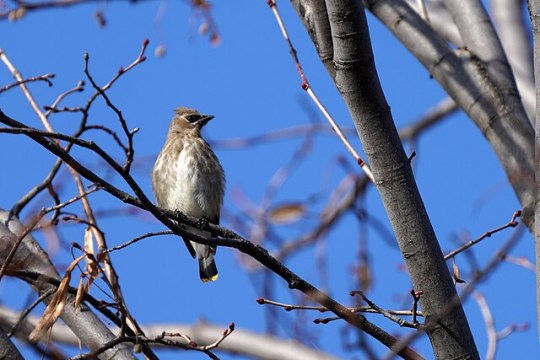
A juvenile cedar waxwing’s coloration differs significantly from that of the adults.
Juvenile cedar waxwings are less brilliantly colored, tending toward a brownish-gray body and head with a white belly, and the facial mask is less extensive. They won’t get their crest or red wingtips until adulthood.
Behaviors – Cedar waxwings are delightfully social birds, and having a flock of them descend on a bush of berries in winter is a treat to watch. Even during breeding season they will nest close to their waxwing neighbors. Their courtship rituals are also adorable, involving hopping back and forth, passing a little gift of food between each other. They raise one to two nests of young a year, each clutch consisting of anywhere from 2-6 babies that have hatched out of light blue or gray eggs, sometimes with darker gray spots.
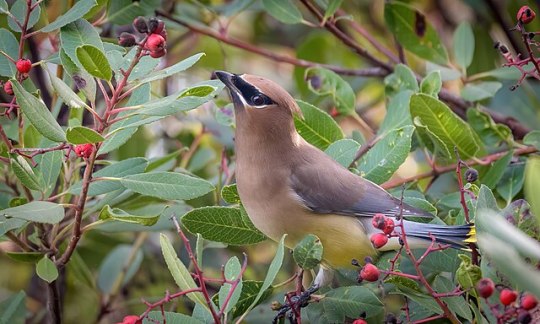
These birds are primarily frugivorous, subsisting on berries and other fruit throughout the year. However, during warmer months they’ll also supplement their diet with insects and other small arthropods. (Native plants are a great way to provide them with both types of food.) They require wooded and shrubby areas to find food and nesting sites, and are quite tolerant of human activity. People nearby may hear the waxwings’ high-pitched trilling and whistling calls; flocks of the birds can create quite a racket of twittering sounds.
In spring it is not uncommon to find cedar waxwings intoxicated by fermented berries from the previous year. As with humans, this can cause uncoordinated movement, and they may injure themselves flying into trees, buildings and other solid objects.
Movement – Waxwings often fly in large groups with swift, short wingbeats similar to that of common starlings (Sturnus vulgaris). When foraging they will hop from branch to branch, swallowing berries whole, and picking off convenient insects when present. They are also known to hunt insects over water, skimming and swooping like swallows.
Other organisms it could be confused with and how to tell the difference: The Bohemian waxwing (Bombycilla garrulus) is almost exactly alike in appearance as the cedar waxwing. However, it is a little larger, and lacks the cedar’s yellow coloration, instead having a gray belly; the brown coloration is limited primarily to the head and neck, and cinnamon under the tail. Look at the folded wing of a Bohemian waxwing, and you’ll see a white stripe that is missing from a cedar’s wing.
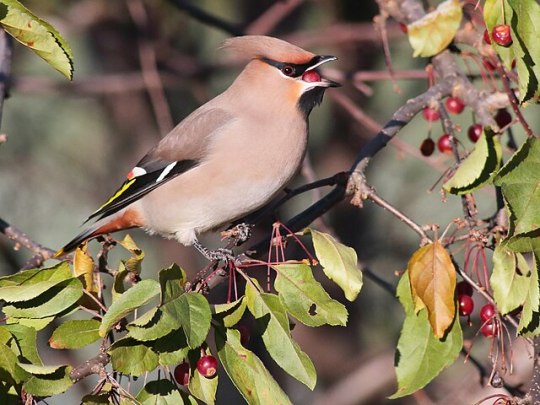
Bohemian waxwing
The tufted titmouse (Baeolophus bicolor) is also a small gray passerine bird with a crest of feathers on the head, but it is significantly smaller than the waxwings. It has a gray head, back, wings and tail, sometimes with a slight brown tint, and a white belly. The sides are rust-colored, though these may extend over most or all of the breast and belly in some individuals. Titmice lack the black mask of the waxwing, and have white on their face and throat. They also do not have the red and yellow tips on their flight feathers.
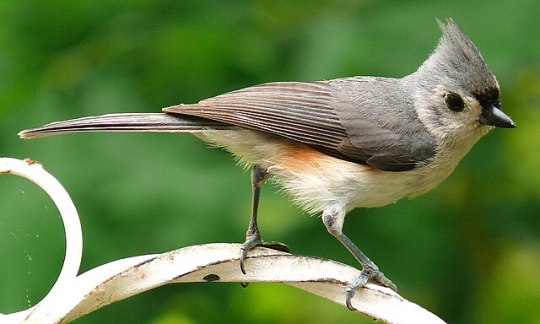
Tufted titmouse
Further Reading:
All About Birds – Cedar Waxwing
Audubon Field Guide – Cedar Waxwing
ABC Bird Library – Cedar Waxwing
Birdweb – Cedar Waxwing
Did you enjoy this post? Consider taking one of my online foraging and natural history classes or hiring me for a guided nature tour, checking out my other articles, or picking up a paperback or ebook I’ve written! You can even buy me a coffee here!
#cedar waxwing#waxwings#birds#passerine birds#songbirds#birding#birdwatching#birbs#nature#wildlife#animals#ecology#nature identification#scicomm#vertebrates#dinosaurs
24 notes
·
View notes
Text




Medicago lupulina (black medick)
Black medick is native to Eurasia and is now found all over the world. This includes every Canadian province, the entire United States (including Alaska) and most of South America. Closely related to clover, black medick is a legume and it's roots have nodules full of bacteria that can fix nitrogen. This useful skill makes it a very successful pioneer plant in disturbed soil. The third photo shows a white clover with much larger leaves, side-by-side with black medick.
Unfortunately, it has taken hold in my rockery. Black medick is a short-lived perennial but if it survives more than a year, it develops a tap root and then it becomes unstoppable. This plant is described as "rather weedy in fields and gardens" in my well-thumbed, 1970 edition of 'Weeds of Canada'. I totally agree. Once a month, I pull handfuls of this stuff out my rockery but a few weeks later - it's back! Believe me, black medick is relentless.
#flowers#photographers on tumblr#black medick#invasive plants#gardening#fleurs#flores#fiori#blumen#bloemen#my garden#Vancouver
56 notes
·
View notes
Text
Solitary bee enjoying the Salidago canadensis 🐝
23 notes
·
View notes
Text

Sanguisorba canadensis / Canadian Burnet at the Sarah P. Duke Gardens at Duke University in Durham, NC
#Sanguisorba canadensis#Sanguisorba#Rosaceae#Canadian Burnet#Burnet#Native plants#Native flowers#Plants#Flowers#Nature photography#photography#photographers on tumblr#Sarah P. Duke Gardens#Duke Gardens#Duke University#Durham#Durham NC#north carolina#🌺🌻
2 notes
·
View notes
Text
Late night thoughts, but seeing white ppl's reaction to landback & Turtle Island & Hawaii has really showed us that so many people still don't understand settler colonialism or why it's bad, or even acknowledge the fact that them being born in Turtle Island does in fact, mean that they have privilege as a result of that settler colonialism.
"My ancestors didn't do any of the killing, so they didn't do any colonizing" You being in Turtle Island is proof that they did in fact, participate in colonization. Even if you know for a fact that your ancestors didn't kill any Indigenous people, the colonizers that DID do that specifically did it so that other White settlers could replace the Indigenous population. That's what settler colonialism is. The settlers that moved here were just as much part of colonization of the Americas as people like Christopher Columbus was.
"My ancestors were mostly farmers" I said this so many times in the past, but yeah they were still colonizers. Natives were pushed off good, farmable land onto reservations (specifically areas that tended to be worse off for farming, crop planting, and hunting) specifically so that white settlers could have the good areas to themselves to farm. The U.S and Canadian government paid for White settlers' travel expenses specifically so that they could come colonize Turtle Island. The gov put out ads to "buy Indian Land!" And people definitely took them up on it. Plenty of poor White people trespassed onto what even was designated as land reserved for Native Americans, and that land automatically became theirs ( and disenfranchised from the tribe) for no reason besides that they were on it. One reason why so many White Americans believe they have specifically a Cherokee ancestor is because there's lots who faked Native lineage in order to steal land from displaced Cherokee. Theres a good chance your ancestors did any one of these things.
I think people have this image of what a "colonizer" is in their head and it's a moustache twirling white villian holding a sword or a musket, so much that they don't remember or realize that "colonizer" or "settler" does very much in fact does also include their pastoral great grandparents who were "immigrants"
4K notes
·
View notes
Text
Some books and stories that I think are worth reading in conversation with Yellowjackets
Shirley Jackson, all works but especially The Sundial, The Haunting of Hill House, and We Have Always Lived in the Castle. Jackson might or might not need any introduction in this fandom. The Sundial is her take on doomsday preppers, Hill House is of course her haunted house novel (one of the classics of that genre), and Castle has a female protagonist who makes Shauna look like a plaster saint.
Flannery O'Connor, The Violent Bear It Away. O'Connor's work has some of the most pervasive darkness and brutality of any major American writer (maybe Ambrose Bierce comes close), and the second of two novels that she completed before her death is no exception. (The first, Wise Blood, is also very good; the intended third, Why Do the Heathen Rage?, only exists as a fragmentary short story.) Francis Marion Tarwater is kidnapped and raised in the woods by his great-uncle, who is convinced that Francis is destined to be a prophet. The great-uncle's death commences a bizarre adventure involving auditory hallucinations, sinister truckers, an evil social worker, arson, developmental disabilities, and baptizing and drowning someone at the same time. Content warnings for all of the above plus rape. O'Connor is also a fairly racist author by today's standards--she was a white Southerner who died in 1964--so keep that in mind as well.
Ruth Ozeki, The Book of Form and Emptiness. Teenage protagonist is schizophrenic and also a channel for a genuinely supernatural force; well-intentioned but poorly-considered efforts to treat one of these issues make the other worse. Sound familiar? There are supporting characters who are affectionate parodies of Slavoj Zizek and Marie Kondo. A minor character is a middle-aged lesbian who cruises dating apps for hookups with much younger women. Some people find this book preachy and overwritten, but I really like it and would plug it even if I didn't because the author is someone whom I've met and who has been supportive of my own writing.
Yukio Mishima, The Decay of the Angel. Can be read in translation or in the original Japanese. This is the fourth and last book in a series called The Sea of Fertility but I wouldn't necessarily recommend the first three as particularly YJ-ish; Decay is because it deals at great length with issues of doubt and ambiguity about whether or not a genuinely held, but personally damaging, spiritual and religious belief is true. There's also more (as Randy Walsh would put it) lezzy stuff than is usual for Mishima, a gay man. Content warnings for elder abuse, sexual abuse of both children and vulnerable adults in previous books in the series, forced abortion in the first book if you decide to read the whole thing from the beginning, and the fact that in addition to being a great novelist the author was also a far-right political personality.
Howard Frank Mosher, Where the Rivers Flow North. An elderly Vermont lumberjack and his Native American common-law wife refuse to sell their land to a development company that wants to build a hydroelectric power plant. Tragedy ensues. I haven't read this one in a long time but some images from the movie stick in my mind as YJ-y. Lots of fire, water, and trees.
Leonard Cohen, Beautiful Losers. Yes, this is the same Leonard Cohen who later transitioned into songwriting and became a household name in that art form. Beautiful Losers is a very weird, very horny novel that he wrote as a young man; it deals with the submerged darkness and internal tension within Canadian and specifically Quebecois society. One of the main characters is Kateri Tekakwitha, a seventeenth-century Iroquois convert to Catholicism who was probably a lesbian in real life (although Cohen unfortunately seems unaware of this). This one actually shows up YJ directly; the song "God Is Alive, Magic Is Afoot" that plays in the season 2 finale takes its lyrics from a particularly strange passage.
Monica Ojeda, Jawbone. Can be read in translation or in the original Spanish. Extremely-online teenage girls at a posh bilingual Catholic high school in Ecuador start their own cult based on such time-honored fodder as Herman Melville novels, internet creepypasta (no, this book does not look or feel anything like Otherside Picnic), and their repressed but increasingly obvious desire for one another. The last part in particular gets the attention of their English teacher, whose own obsessive internalized homophobia grows into one of the most horrifying monstrous versions of itself I've ever read. Content warning for just about everything that could possibly imply, but especially involuntary confinement, religious and medical abuse, and a final chapter that I don't even know how to describe. Many thanks to @maryblackwood for introducing me to this one.
Jorge Luis Borges, lots of his works but especially "The Aleph," "The Cult of the Phoenix," and "The South." Can be read in translation or in the original Spanish. The three works I list are all short stories. The first deals with mystical experiences and the comprehensibility (or lack thereof) of the universe, the second with coded and submerged references to sexuality in general and homosexuality in particular, the third with leaving your well-appointed city home for a ranch in the middle of nowhere and almost immediately dying in a knife fight, which is surely a very YJ series of things to do.
H.P. Lovecraft, "The Colour out of Space," "The Dunwich Horror," "The Dreams in the Witch House," and "The Thing on the Doorstep." Lovecraft in general needs no introduction--the creepiness, the moroseness, the New Englandness, the purple heliotrope prose, his intense racism (recanted late in life but not in time to make any difference in his reception history) and the way his work reflects his fear of the Other. These short stories are noteworthy for having settings that are more woodsy and less maritime than is usual for Lovecraft's New England, for overtones of the supernatural rather than merely the alien, for featuring some of his few interesting female characters, and for their relative lack of obvious racial nastiness. Caveat lector nevertheless.
Herman Melville, Moby-Dick. It's Moby-Dick. Once you realize that Captain Ahab is forming a cult around the whale and his obsession with it you can't unrealize it.
216 notes
·
View notes
Text
SEATTLE (AP) — The world's largest hornet, an invasive breed dubbed the “murder hornet” for its dangerous sting and ability to slaughter a honey bee hive in a matter of hours, has been declared eradicated in the U.S., five years after being spotted for the first time in Washington state near the Canadian border.
The Washington and U.S. Departments of Agriculture announced the eradication Wednesday, saying there had been no detections of the northern giant hornet in Washington since 2021.
The news represented an enormous success that included residents agreeing to place traps on their properties and reporting sightings, as well as researchers capturing a live hornet, attaching a tiny radio tracking tag to it with dental floss, and following it through a forest to a nest in an alder tree. Scientists destroyed the nest just as a number of queens were just beginning to emerge, officials said.
“I’ve gotta tell you, as an entomologist — I’ve been doing this for over 25 years now, and it is a rare day when the humans actually get to win one against the insects," Sven Spichiger, pest program manager of the Washington State Department of Agriculture, told a virtual news conference.
The hornets, which can be 2 inches (5 cm) long and were formerly called Asian giant hornets, gained attention in 2013, when they killed 42 people in China and seriously injured 1,675. In the U.S., around 72 people a year die from bee and hornet stings each year, according to data from the National Institutes of Health.
The hornets were first detected in North America in British Columbia, Canada, in August 2019 and confirmed in Washington state in December 2019, when a Whatcom County resident reported a specimen. A beekeeper also reported hives being attacked and turned over specimens in the summer of 2020. The hornets could have traveled to North America in plant pots or shipping containers, experts said.
DNA evidence suggested the populations found in British Columbia and Washington were not related and appeared to originate from different countries. There also have been no confirmed reports in British Columbia since 2021, and the nonprofit Invasive Species Centre in Canada has said the hornet is also considered eradicated there.
Northern giant hornets pose significant threats to pollinators and native insects. They can wipe out a honey bee hive in as little as 90 minutes, decapitating the bees and then defending the hive as their own, taking the brood to feed their own young.
The hornet can sting through most beekeeper suits, deliver nearly seven times the amount of venom as a honey bee, and sting multiple times. At one point the Washington agriculture department ordered special reinforced suits from China.
Washington is the only state that has had confirmed reports of northern giant hornets. Trappers found four nests in 2020 and 2021.
Spichiger said Washington will remain on the lookout, despite reporting the eradication. He noted that entomologists will continue to monitor traps in Kitsap County, where a resident reported an unconfirmed sighting in October but where trapping efforts and public outreach have come up empty.
He noted that other invasive hornets can also pose problems: Officials in Georgia and South Carolina are fighting yellow-legged hornets, and southern giant hornets were recently detected in Spain.
“We will continue to be vigilant,” Spichiger said.
16 notes
·
View notes